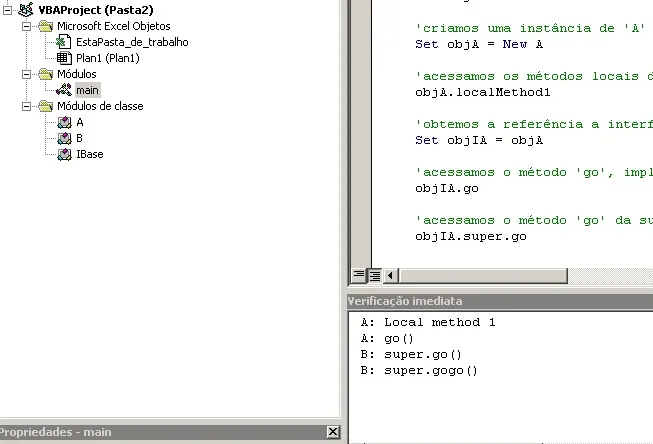这是我长期以来使用的一种方式,通过接口模拟抽象类。
'class module: IBase
'We define a base interface
'
Sub go(): End Sub
Sub gogo(): End Sub
现在让我们定义其他类,从抽象类'B'开始。
'
'class module: B
'
Implements IBase
'Daughter classes should implement 'go'
'Note that the method is 'Public'
Public Sub go(): End Sub
'Let's agree that every daughter class implements the method
'abstract 'super' that returns the IBase interface
Public Property Get super() As IBase: End Property
'
'The signature of other abstract methods can be stated here
'
'Public Sub goGoChild(): End Sub
'Public Function goGoGoChild2(): End Function
'
'
'Note that the methods are accessible through the IBase interface
'
Private Sub IBase_go()
Debug.Print "B: super.go()"
End Sub
Private Sub IBase_gogo()
Debug.Print "B: super.gogo()"
End Sub
让我们创建一个实现抽象类'B'的类'A'
'
'class module: 'A'
'
'We started implementing the abstract class B
Implements B
'we define a private type 'myType'
Private Type myType
'variable that references an instance of 'B'
objB As B
'variable that references the interface of 'B'
objIB As IBase
End Type
'VBA version of 'this'
Private this As myType
'
'Every class that implements 'B' (abstract class)
'you must initialize in your constructor some variables
'of instance.
'
Private Sub Class_Initialize()
With this
'we create an instance of object B
Set .objB = New B
'the variable 'objIB' refers to the IBase interface, implemented by class B
Set .objIB = .objB
End With
End Sub
'Visible only for those who reference interface B
Private Property Get B_super() As IBase
'returns the methods implemented by 'B', through the interface IBase
Set B_super = this.objIB
End Property
Private Sub B_go()
Debug.Print "A: go()"
End Sub
'==================================================
'Class 'A' local method
Sub localMethod1()
Debug.Print "A: Local method 1"
End Sub
最后,让我们创建“main”模块。
Sub testA()
'reference to class 'A'
Dim objA As A
'reference to interface 'B'
Dim objIA As B
'we create an instance of 'A'
Set objA = New A
'we access the local methods of instance 'A'
objA.localMethod1
'we obtain the reference to interface B (abstract class) implemented by 'A'
Set objIA = objA
'we access the 'go' method, implemented by interface 'B'
objIA.go
'we go to the 'go' method of the super class
objIA.super.go
'we access the 'gogo' method of the super class
objIA.super.gogo
End Sub
输出结果将显示在验证窗口中:
A: Local method 1
A: go()
B: super.go()
B: super.gogo()

